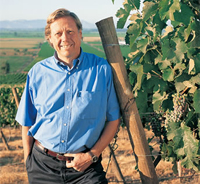Can Chilean wines age? A Montes challenge
Just over thirty years ago, Chilean wines entered the world wine stage. As with the export trajectory of Japanese car manufacturers, Chilean wine makers started by exporting inexpensive but reliable offerings. And as with the Japanese car manufacturers, they eventually became so proficient at the low end that they began to target the high end and focus on quality.
 Montes is one of the more recent quality producers, more Lexus than Toyota (although they do have reliable wines at $10). Started in 1987 as a partnership between Aurelio Montes and Douglas Murray, the company now makes wines in Argentina under the Kaiken brand and in Napa, from Rutherford and Coombsville, to be released in 2008.
Montes is one of the more recent quality producers, more Lexus than Toyota (although they do have reliable wines at $10). Started in 1987 as a partnership between Aurelio Montes and Douglas Murray, the company now makes wines in Argentina under the Kaiken brand and in Napa, from Rutherford and Coombsville, to be released in 2008.
At a recent tasting in New York City with Aurelio Montes, a key question for me was: can Chilean wines age? With eight vintages of the Alpha M (a cabernet-dominant blend, generally about $80 retail) in front of me dating back to 1997, I tasted through to find the answer to be yes but the record is short and mixed. I also found out about the mysterious phenomenon of the “annual rhythm.”
First to the tasting. My favorite Alpha M was the 2003. This big, lush wine was well integrated with smooth tannins and notes of blackberries, cassis, and saddle leather. Aurelio suggested it had the stuffing to last another ten years. I could see that.
The 2005 was my next favorite, a big, frisky Labrador of a wine with toasty oak notes. It had higher alcohol than the 03 with 14.5% vs 14%. Approachable now in its youth, I would like to see a few years of bottle age on it to see it mellow a bit. You know, a Labrador at the end of a day, sitting by the fire.
My next two faves were the 2001 and the 1997. These wines exhibited more maturity and the 2001 was still big and fresh but showed more refinement than the younger vintages. The 1997 had the brick red coloring of older cabernet and did have more mature fruits rather than fresh with a faint mustiness, sort of “grandma’s attic.” But it was rewarding and worthwhile, like an (even) older wine from the Medoc. The 1999 was also solid, drinking well now. Of note, the alcohol level rose from 13.5 in 1997 to 14.9% in 2004, mirroring a trend seen around the wine world.
The Da Vinci Code numerologists among you will have noticed that all of these vintages are from odd-numbered years. In the “annual rhythm,” Aurelio explained to me over lunch that there is indeed vintage variation in Chile despite it being “paradise” for vines, a land spared the vineyard afflictions of phylloxera, mildew, Pierce’s Disease, and summer rain. While some years may be knocked out completely by El Nino, a pattern has emerged where the even-numbered years are lower quality. Aurelio suggested that in a sort of rhythm, the vine pushes one year, and then has quiet year the next.
In this tasting, my bottle of 1998 was oxidized, the 2000 was the best of the even years, the 2002 was nonexistent and the 2004 had grippy, peppery tannins but this Alpha M was still “the best of the worst” year according to Aurelio.
If Montes is a Lexus, then the winery’s barrel room is the garage. Maybe the Gregorian chants that Aurelio plays at his Feng Shui winery will help soothe those wines from even-numbered years as they slumber.
(Image: Montes)




On July 6th, 2009 at 3:13 pm ,Gerhard wrote:
Hallo,
I saw your post right now, jumping back from the recent post on Viu´s 62 points.
I agree that vintage variations exist in Chile, but i don´t think the even/uneven system works. True, 1998 was a “El Niño” year and has a bad reputation, but many 1998s are in excellent shape now and have outlived the 1999s.
And sure, Chilean wines can age well, especially those with sufficient acidity. A Montes Alpha CS 1991, tasted in 2008, was delicious (I wouldn´t say the same about the more recent creations). Don Melchor 1989 and 1995 are excellent right now. A Gillmore Cabernet Franc 1998 was delicious 2 weeks ago. The list is long. In sum, especially for the old-style red wines from Chile, there is no reason not to age well and there are examples of wines from the 1960s and 1970s that still drink well if well-stored (unfortunately not easy to find in Chile)…. Cheers, Gerhard